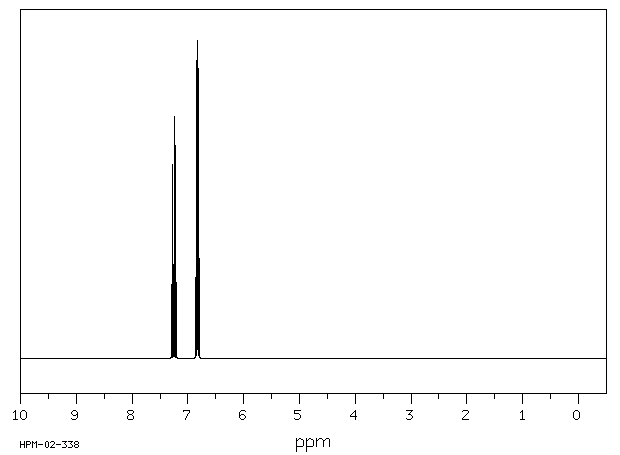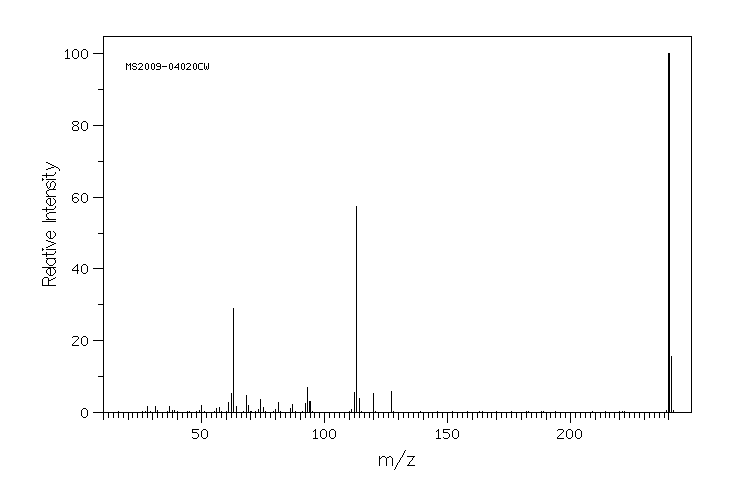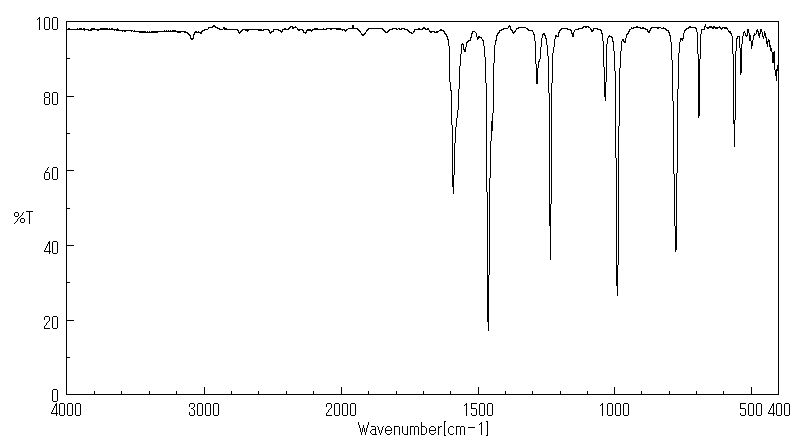2,6-二氟碘苯 | 13697-89-7
-
物化性质
-
计算性质
-
ADMET
-
安全信息
-
SDS
-
制备方法与用途
-
上下游信息
-
文献信息
-
表征谱图
-
同类化合物
-
相关功能分类
-
相关结构分类
物化性质
-
熔点:24-26℃
-
沸点:186℃
-
密度:2.001
-
闪点:69℃
计算性质
-
辛醇/水分配系数(LogP):2.8
-
重原子数:9
-
可旋转键数:0
-
环数:1.0
-
sp3杂化的碳原子比例:0.0
-
拓扑面积:0
-
氢给体数:0
-
氢受体数:2
安全信息
-
危险等级:IRRITANT
-
危险品标志:Xi
-
海关编码:2903999090
-
危险性防范说明:P261,P301+P312,P302+P352,P304+P340,P305+P351+P338
-
危险性描述:H302,H315,H319,H335
-
储存条件:0-10°C;应避免加热。
SDS
模块 1. 化学品
产品名称: 1,3-Difluoro-2-iodobenzene
修改号码: 5
模块 2. 危险性概述
GHS分类
物理性危害 未分类
健康危害
皮肤腐蚀/刺激 第2级
严重损伤/刺激眼睛 2A类
环境危害 未分类
GHS标签元素
图标或危害标志
信号词 警告
危险描述 造成皮肤刺激
造成严重眼刺激
防范说明
[预防] 处理后要彻底清洗双手。
穿戴防护手套/护目镜/防护面具。
[急救措施] 眼睛接触:用水小心清洗几分钟。如果方便,易操作,摘除隐形眼镜。继续冲洗。
眼睛接触:求医/就诊
皮肤接触:用大量肥皂和水轻轻洗。
若皮肤刺激:求医/就诊。
脱掉被污染的衣物,清洗后方可重新使用。
模块 3. 成分/组成信息
单一物质/混和物 单一物质
化学名(中文名): 1,3-二氟-2-碘苯
百分比: >98.0%(GC)
CAS编码: 13697-89-7
分子式: C6H3F2I
1,3-二氟-2-碘苯 修改号码:5
模块 4. 急救措施
吸入: 将受害者移到新鲜空气处,保持呼吸通畅,休息。若感不适请求医/就诊。
皮肤接触: 立即去除/脱掉所有被污染的衣物。用大量肥皂和水轻轻洗。
若皮肤刺激或发生皮疹:求医/就诊。
眼睛接触: 用水小心清洗几分钟。如果方便,易操作,摘除隐形眼镜。继续清洗。
如果眼睛刺激:求医/就诊。
食入: 若感不适,求医/就诊。漱口。
紧急救助者的防护: 救援者需要穿戴个人防护用品,比如橡胶手套和气密性护目镜。
模块 5. 消防措施
合适的灭火剂: 干粉,泡沫,雾状水,二氧化碳
特殊危险性: 小心,燃烧或高温下可能分解产生毒烟。
特定方法: 从上风处灭火,根据周围环境选择合适的灭火方法。
非相关人员应该撤离至安全地方。
周围一旦着火:如果安全,移去可移动容器。
消防员的特殊防护用具: 灭火时,一定要穿戴个人防护用品。
模块 6. 泄漏应急处理
个人防护措施,防护用具, 使用个人防护用品。远离溢出物/泄露处并处在上风处。
紧急措施: 泄露区应该用安全带等圈起来,控制非相关人员进入。
环保措施: 防止进入下水道。
控制和清洗的方法和材料: 清扫收集粉尘,封入密闭容器。注意切勿分散。附着物或收集物应该立即根据合适的
法律法规处置。
模块 7. 操作处置与储存
处理
技术措施: 在通风良好处进行处理。穿戴合适的防护用具。防止粉尘扩散。处理后彻底清洗双手
和脸。
注意事项: 如果粉尘或浮质产生,使用局部排气。
操作处置注意事项: 避免接触皮肤、眼睛和衣物。
贮存
储存条件: 保持容器密闭。存放于凉爽、阴暗处。
远离不相容的材料比如氧化剂存放。
包装材料: 依据法律。
模块 8. 接触控制和个体防护
工程控制: 尽可能安装封闭体系或局部排风系统,操作人员切勿直接接触。同时安装淋浴器和洗
眼器。
个人防护用品
呼吸系统防护: 防尘面具。依据当地和政府法规。
手部防护: 防护手套。
眼睛防护: 安全防护镜。如果情况需要,佩戴面具。
皮肤和身体防护: 防护服。如果情况需要,穿戴防护靴。
模块 9. 理化特性
固体
外形(20°C):
外观: 晶体
颜色: 白色-极淡的黄色
气味: 无资料
1,3-二氟-2-碘苯 修改号码:5
模块 9. 理化特性
pH: 无数据资料
熔点: 24°C (凝固点)
沸点/沸程 71 °C/1.9kPa
闪点: 无资料
爆炸特性
爆炸下限: 无资料
爆炸上限: 无资料
密度: 无资料
溶解度:
[水] 无资料
[其他溶剂] 无资料
模块 10. 稳定性和反应性
化学稳定性: 一般情况下稳定。
危险反应的可能性: 未报道特殊反应性。
须避免接触的物质 氧化剂
危险的分解产物: 一氧化碳, 二氧化碳, 碘化氢, 氟化氢
模块 11. 毒理学信息
急性毒性: 无资料
对皮肤腐蚀或刺激: 无资料
对眼睛严重损害或刺激: 无资料
生殖细胞变异原性: 无资料
致癌性:
IARC = 无资料
NTP = 无资料
生殖毒性: 无资料
模块 12. 生态学信息
生态毒性:
鱼类: 无资料
甲壳类: 无资料
藻类: 无资料
残留性 / 降解性: 无资料
潜在生物累积 (BCF): 无资料
土壤中移动性
log水分配系数: 无资料
土壤吸收系数 (Koc): 无资料
亨利定律 无资料
constaNT(PaM3/mol):
模块 13. 废弃处置
如果可能,回收处理。请咨询当地管理部门。建议在可燃溶剂中溶解混合,在装有后燃和洗涤装置的化学焚烧炉中
焚烧。废弃处置时请遵守国家、地区和当地的所有法规。
模块 14. 运输信息
联合国分类: 与联合国分类标准不一致
UN编号: 未列明
1,3-二氟-2-碘苯 修改号码:5
模块 15. 法规信息
《危险化学品安全管理条例》(2002年1月26日国务院发布,2011年2月16日修订): 针对危险化学品的安全使用、
生产、储存、运输、装卸等方面均作了相应的规定。
模块16 - 其他信息
N/A
制备方法与用途
上下游信息
-
上游原料
中文名称 英文名称 CAS号 化学式 分子量 2,3,4,5,6-五氟碘苯 1,2,3,4,5-pentafluoro-6-iodobenzene 827-15-6 C6F5I 293.963 -
下游产品
中文名称 英文名称 CAS号 化学式 分子量 2,4-二氟碘苯 2,4-difluoro-1-iodobenzene 2265-93-2 C6H3F2I 239.991 —— 2,4-difluoro-3-iodoaniline 1437316-91-0 C6H4F2IN 255.006
反应信息
-
作为反应物:参考文献:名称:Stable electrodes with modified work functions and methods for organic electronic devices摘要:一种实施例是一种方法,包括:将分子沉积在电极上,其中电极具有一个表面,而分子具有一个结合基团(例如,一个锚定基团),该基团与表面结合,从而在环境条件下至少稳定100小时,提供一个工作函数。公开号:US20110114935A1
-
作为产物:参考文献:名称:提高选择性氟化低聚苯基有机半导体的电荷迁移率:一种基于实验和计算观点的设计方法†摘要:氟化可用于在分子水平上调节光电性能。已经合成,结晶,结构解析并通过计算分析了电荷迁移率的一系列具有各种苯环二氟化的低聚苯基。我们发现在对位的苯环的二氟化导致寡聚苯基以对称重叠的方式堆叠,并显着增强了空穴迁移率以及所考虑分子的最高电子迁移率。其他二氟化导致π堆叠晶体中分子单元的相对移动,从而导致迁移率降低。使用Suzuki-Miyaura交叉偶联反应合成了选择性氟化的寡苯基。产品的结构通过X射线衍射(XRD)进行表征,1 H, 13 C, 19 F NMR光谱和气相色谱(GC)/质谱(MS)测量。基于最先进工具的材料计算分析可用于预测其在结晶相中的电荷传输性能。简而言之,我们建立了一种基于寡苯基氟化的分子设计方法,以实现增强的空穴迁移率和相对较高的电子迁移率。DOI:10.1039/c8tc06517a
文献信息
-
Efficient one-pot transformation of aminoarenes to haloarenes using halodimethylisulfonium halides generated in situ作者:Woonphil Baik、Wanqiang Luan、Hyun Joo Lee、Cheol Hun Yoon、Sangho Koo、Byeong Hyo KimDOI:10.1139/v05-026日期:2005.3.1
Halodimethylsulfonium halide 1, which is readily formed in situ from hydrohaloic acid and DMSO, is a good nucleophilic halide. This activated nucleophilic halide rapidly converts aryldiazonium salt prepared in situ by the same hydrohaloic acid and nitrite ion to aryl chlorides, bromides, or iodides in good yield. The combined action of nitrite ion and hydrohaloic acid in DMSO is required for the direct transformation of aromatic amines, which results in the production of aryl halides within 1 h. Substituted compounds with electron-donating or -withdrawing groups or sterically hindered aromatic amines are also smoothly transformed to the corresponding aromatic halides. The only observed by-product is the deaminated arene (usually <7%). The isolated aryldiazonium salts can also be converted to the corresponding aryl halides using 1. The present method offers a facile, one-step procedure for transforming aminoarenes to haloarenes and lacks the environmental pollutants that usually accompany the Sandmeyer reaction using copper halides. Key words: aminoarenes, haloarenes, halodimethylsulfonium halide, halogenation, amination.
卤二甲基亚砜卤化物1是一种良好的亲核卤化物,可在现场由氢卤酸和二甲亚砜形成。这种活化的亲核卤化物迅速将由相同的氢卤酸和亚硝酸根在现场制备的芳基重氮盐转化为芳基氯化物、溴化物或碘化物,收率较高。在DMSO中,亚硝酸根和氢卤酸的联合作用是直接转化芳香胺的必要条件,从而在1小时内产生芳基卤化物。带有电子给体或吸引基团或有立体位阻的芳香胺的取代化合物也可顺利转化为相应的芳香卤化物。观察到的唯一副产物是去氨基芳烃(通常<7%)。孤立的芳基重氮盐也可以使用1转化为相应的芳基卤化物。该方法提供了一种简便的、一步法的程序,用于将氨基芳烃转化为卤代芳烃,并且不伴随通常伴随使用铜卤化物进行桑迈尔反应的环境污染物。关键词:氨基芳烃,卤代芳烃,卤二甲基亚砜卤化物,卤化,胺化。 -
[EN] TRIAZOLE PHENYL COMPOUNDS AS AGONISTS OF THE APJ RECEPTOR<br/>[FR] COMPOSÉS PHÉNYLE TRIAZOLE EN TANT QU'AGONISTES DU RÉCEPTEUR APJ申请人:AMGEN INC公开号:WO2018093579A1公开(公告)日:2018-05-24Compounds of Formula I and Formula II, pharmaceutically acceptable salt thereof, stereoisomers of any of the foregoing, or mixtures thereof are agonists of the APJ Receptor and may have use in treating cardiovascular and other conditions. Compounds of Formula I and Formula II have the following structures: (I), (II) where the definitions of the variables are provided herein.公式I和公式II的化合物,其药用盐,上述任何一个的立体异构体,或它们的混合物是APJ受体的激动剂,可能用于治疗心血管和其他疾病。公式I和公式II的化合物具有以下结构:(I),(II),其中变量的定义在此提供。
-
[EN] NOVEL BETA 3 ADRENERGIC RECEPTOR AGONISTS<br/>[FR] NOUVEAUX AGONISTES DU RÉCEPTEUR BÊTA 3 ADRÉNERGIQUE申请人:MERCK SHARP & DOHME公开号:WO2011137054A1公开(公告)日:2011-11-03The present invention provides compounds of Formula (I), pharmaceutical compositions thereof, and methods of using the same in the treatment or prevention of diseases mediated by the activation of b3-adrenoceptor.本发明提供了式(I)的化合物,其药物组成物以及在治疗或预防由b3-肾上腺素受体激活介导的疾病中使用这些化合物的方法。
-
New bicyclic compounds as crac channel modulators申请人:Almirall, S.A.公开号:EP2738172A1公开(公告)日:2014-06-04The present invention relates to novel compounds which are inhibitors of CRAC channel activity. This invention also relates to pharmaceutical compositions containing them, process for their preparation and their use in therapy.这项发明涉及一种新型化合物,它们是CRAC通道活性的抑制剂。该发明还涉及含有这些化合物的药物组合物,它们的制备方法以及它们在治疗中的应用。
-
PDE4 INHIBITOR申请人:SHIJIAZHUANG SAGACITY NEW DRUG DEVELOPMENT CO., LTD.公开号:US20190177318A1公开(公告)日:2019-06-13Provided are a PDE4 inhibitor and a use thereof in the preparation of a medicament for treating PDE4 related diseases. Specifically disclosed are the compound as shown in formula (I) and a pharmaceutically acceptable salt thereof.提供了一种PDE4抑制剂及其在制备用于治疗与PDE4相关疾病的药物中的用途。具体披露了如公式(I)所示的化合物及其药用可接受的盐。
表征谱图
-
氢谱1HNMR
-
质谱MS
-
碳谱13CNMR
-
红外IR
-
拉曼Raman
-
峰位数据
-
峰位匹配
-
表征信息










